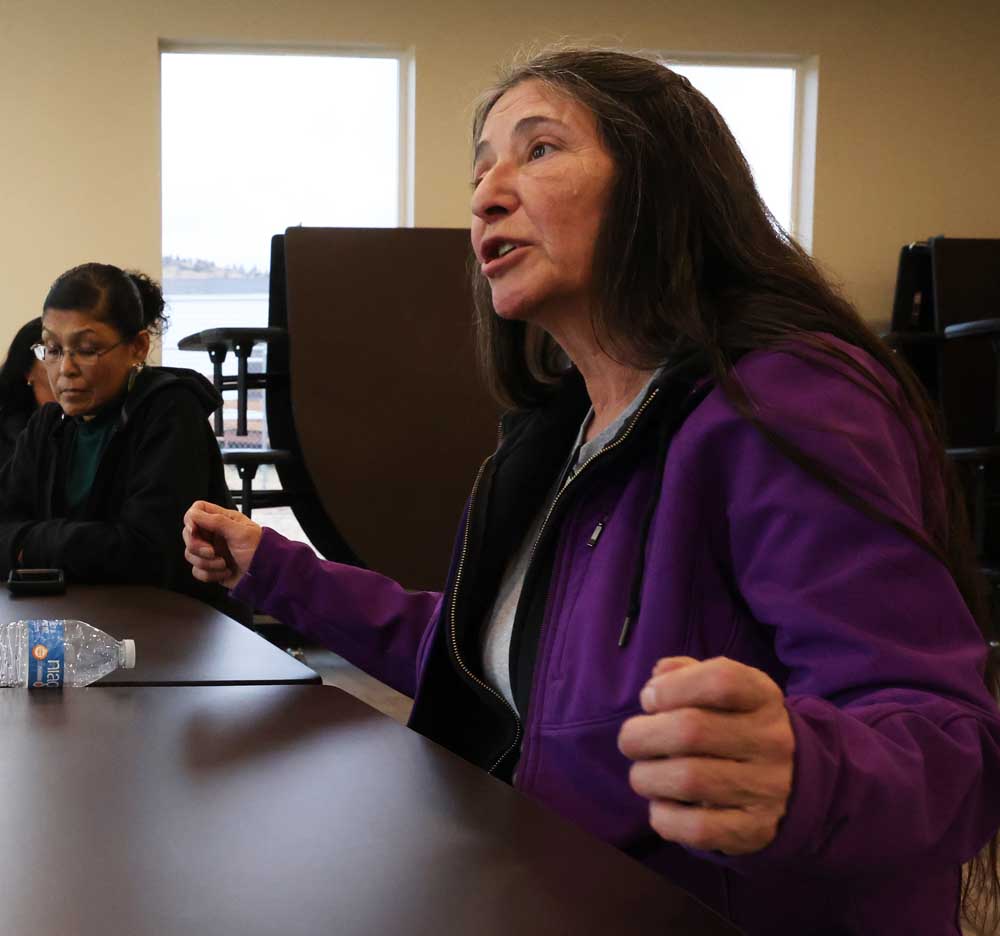Warm Springs addresses Indigenous homelessness with culture, connection and housing-first model
Published 5:45 am Saturday, November 9, 2024

- Danielle Wood, director of the Warm Springs Housing Authority, talks about the new 10-unit supportive housing complex on the Warm Springs Indian Reservation, where homelessness affects a disproportionate number of people.
Greg Youngman kept his ceremonial medicine sticks by his side the whole time he was homeless for 14 years. The sticks — thick, smooth and tied with a blue bandana — were among the items he salvaged when his home burned in a fire in 2010. He carried them wrapped in bags as he moved between camps in Warm Springs and Madras.
Now they rest on a table against a wall behind a lamp in his living room.
Youngman is still adjusting to the confines of four walls and a roof. He spent little time inside his new 660-square-foot home in the first few days after moving in, leaving for hours on end at night. He couldn’t get used to the echo.
A month later, he’s getting used to staying inside. Others have noticed his demeanor changing. His smile has returned.
Youngman is one of 12 Warm Springs tribal members who are no longer homeless after moving into the Confederated Tribes of Warm Springs’ new permanent supportive housing complex for tribal members. Many are still adjusting to their new homes after years — decades in some cases — of living on the streets, as tribal leaders seek to address a homelessness crisis that skyrocketed on the Warm Springs Indian Reservation during the COVID-19 pandemic.
“I’ve known all of them almost all my life,” said Warm Springs Housing Authority Director Danielle Wood. “To see the change in them that quick … it took a long time for them to get to where they were. For them to bounce back up so quick, it’s exciting.”
Supportive housing project opens in Warm Springs
Permanent supportive housing, a model deployed by the state of Oregon and widely backed as a successful way to lift people from chronic homelessness, pairs housing with services, programs and other assistance, in which participation is voluntary.
Warm Springs behavioral health staff offer counseling, lifestyle classes and self-improvement classes. Staff from the housing department make sure residents’ basic needs are met, and help with finding other housing if they ever decide to move on.
But as long as they want, they’ll have a home to return to.
Family ties
Lottie White left her home in Warm Springs at the age of 20, and has spent the past four decades more or less without one. She lived mostly in camps in Madras, where she often cooked and cared for dozens of others, she said.
She was forced to move from a camp at Willow Creek in Madras earlier this year as part of a major sweep conducted by the city.
Madras’ largest homeless camp disbanded as city seeks to enforce rules
Lottie White’s sister, Andrea, lived homeless near the Rainbow Market, just across the river from the Warm Springs reservation. She recalled spending winter nights with temperatures below zero.
“That hurts,” Andrea said. “It makes you freeze.”
Now the two are neighbors in supportive housing, what residents have lovingly dubbed “Smurf Village” because the houses are covered in bright blue paint.
The change took some getting used to, Lottie said: the feeling of holding keys in her hand, not having to constantly think about finding firewood and food, and making reference to her home rather than her tent.
“This is teaching me how to live by myself again. I haven’t done that in a long time,” she said.
“I can go home now. I can be more responsible. I don’t want to lose it.”
The sisters have help from other close family in their transition. Edna Campuzano works for the Warm Springs Housing Authority as a resident services specialist, a job created specifically for the new supportive housing project. She’s also Andrea’s daughter.
Part of her job is to walk around and check on residents, including her mother and aunt, just to make sure they’re doing fine.
“They’re used to seeing me,” she said. “They probably see me too much, but that’s OK.”
Several residents are affected by past trauma. Theo McKinley, 70, was drafted into the Vietnam War out of Warm Springs in 1972. In the past eight years he has lost his wife and multiple children.
Youngman’s wife died in April, and he’s still dealing with the death of his son in a 2017 automobile crash.
“I was just about ready to throw in the towel,” Youngman said.
Campuzano said it was a big step for her mother and others simply to accept housing after so many years living homeless. Campuzano has worked for the tribe’s housing authority for seven years, and said homelessness in her family was part of her motivation for getting into social work.
Homelessness jumped on reservation
Homelessness among Native Americans and Alaska Natives has jumped by 53% since 2015, according to the National Alliance to End Homelessness. Indigenous people are about four times as likely to be homeless than average, according to the alliance.
In Central Oregon, Indigenous people make up nearly 10% of the homeless population, but only 2% of the overall population, according to the 2024 Point-in-Time Count.
When the Warm Springs Housing Authority applied for a supportive housing grant through the state in 2019, hardly more than a dozen people were homeless on the reservation, said Wood, the housing director. Today there are 91 homeless people living in Warm Springs, according to the 2024 Point-in-Time Count. That’s an increase from 73 in 2023 and 22 in 2022.
The tribe’s housing authority receives federal funding for subsidized housing, while an emergency shelter in Warm Springs has a 23-bed capacity. But the new project, funded entirely with $4 million from the Oregon Department of Housing and Community Services, fills a major gap on the reservation, reaching populations who have the least chance of being able to rent, Wood said.
It follows the “housing first” principle — that providing stable housing without heavy strings attached is the most effective way to get people out of homelessness. The U.S. Department of Housing and Urban Development cites “overwhelming” evidence that housing-first programs decrease rates of homelessness, and can shorten stays in hospitals while reducing strain on other services. A similar model providing 76 units was recently completed in Bend.
Former Bend motel is region’s first ‘housing first’ model to address homelessness
The Confederated Tribes of Warm Springs is the only tribal group in Oregon that has built supportive housing units through the state’s Housing Development Grant Program, according to Delia Hernandez, a spokesperson for the state housing agency.
The new housing complex has room for 12 people, but 52 people applied to live in it. . As the housing authority works to fine-tune its model, there aren’t immediate plans to build more units, Wood said.
“Who we are as a nation always comes back to our people. When our people struggle, whether that is with substance use or with finding housing, it becomes an automatic priority for our tribal government,” said Tribal Council Chairman Jonathan Smith of the Confederated Tribes of Warm Springs in a statement. “While we have a lot of hard work ahead to ensure that all members in need have the support and safety necessary to embark on their path to healing and security, we have the Warm Springs Housing Authority and our federal and state partners to thank for lighting the way forward.”
Integrating cultural practices
Supportive housing tenants attended a recent funeral ceremony at the Warm Springs Community Center a few blocks away from their homes. They helped serve food, and Wendell “Eagle” Green played his drum.
Warm Springs staff are making sure cultural practices aren’t overlooked as part of the residents’ new lives, said Housing Manager Lisa Lomas Mayer. Some are using the “Red Road,” an approach to mental health and substance use treatment rooted in Native American cultural practices.
Warm Springs culture celebrated on OSU-Cascades campus
“A lot of our healing spiritually is through songs. That’s something that’s practiced here,” Mayer said. “A lot of them are feeding off each other, piggybacking, and being reintroduced to things they were taught when they were younger to get reacquainted in that way.”
For Youngman, things are slowly falling into place. He’s learning how to start all over again — getting a driver’s license, setting up unemployment, getting a bank account and insurance. As he slips back into the routine of daily household chores, he keeps the medicine sticks close by.








